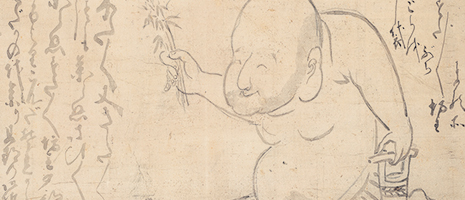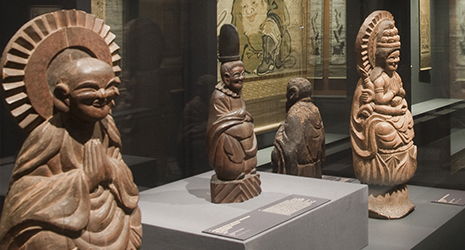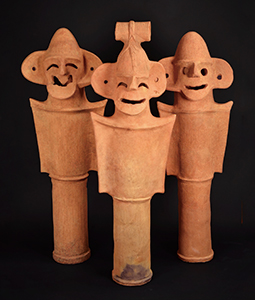Home > Highlighting JAPAN > Highlighting Japan June 2017 > A Unique Comedy Culture
Highlighting JAPAN


Art that Wears a Smile on Its Face
The origin of emojis and emoticons, tools we cannot live without when using SNS, may have their roots in early Japanese art.
Since ancient times, Japanese people have embodied humor in their own unique way through pictures and figurative art forms. The roots can be traced back to the earthen figures made of clay that were produced throughout Japan during the Jomon period (15,000-2,300 years ago). There are various views as to why these earthen figures were produced. Some say they were produced as children’s toys. Others say they were statues and amulets of the gods. The majority of them appear to be females and have smiles on their faces.
Mami Hirose, who curated the exhibition “The Smile in Japanese Art” that was held at the Mori Art Museum in 2007 as well as “WARAI: L’humour dans l’art japonais de la préhistoire au XIXe siècle” (WARAI: Humor in Japanese Art from Prehistory to the 19th Century) that was held at the Japan Foundation’s Japan Cultural Institute in Paris (Maison de la culture du Japon à Paris) in 2012, explained the expression of humor in the history of Japanese art as follows.
“In Japan, there is a proverb that says ‘Warau kado niwa fuku kitaru’ (Fortune comes to a merry home), and people believe that good fortune gravitates naturally to homes in which smiling people live. In other words, they believe that the smile itself has the power to purge evil, and that is clearly demonstrated in the burial mound figurines produced in the Kofun period (c. 250–538).”
Burial mound figurines are unglazed pottery, and each depicts an image of a house, equipment, a person or an animal. They were buried alongside old tumuli where persons of power were laid to rest. One of these large burial mound figurines, known as “tatemochibito,” which was unearthed in Saitama Prefecture, is approximately 1 meter high, and stands with a broad smile on its face and a shield in its hand. This is because people believed that the smile would prevent evil from entering and protect their master from the attacks of foreign enemies.
Since the Muromachi period (1336–1573) and up until modern times, many renowned Japanese artists have repeatedly painted Hanshan and Shide, both legendary monks from the Tang Dynasty period (618–907) in China. They have been adored as popular subjects of works of art, and their trademarks are their meaningful yet eerie smiles. In fact, they have been referred to as a reincarnation of Fugen and Monju, two figures worshipped in Buddhism. They are icons that explain one aspect of the religious beliefs held by Japanese people.
“I believe that ‘smiling gods and Buddha’ is a distinctive means of expression that originated in Japan. Contrary to the meaningful smiles of Hanshan and Shide, Hakuin (1685–1768), who was a high priest of the Rinzai school, one of the schools of Zen Buddhism, applied humor as a method in order to spread the difficult Zen teachings and educate illiterate members of the public on the topic.”
One of the Buddhist pictures painted by Hakuin, Hamaguri Kannon (Kannon emerging from a clam shell), depicts anthropomorphic sea creatures including prawns, octopuses and an old lady with a turtle on her head, all surrounding and worshipping the Kannon Buddhist who rises above a hard clam. What Hakuin was trying to do was to teach illiterate people the important message of Buddhism, which is to save all living creatures, through happy smiles on the faces of sea creatures. Another picture, Hotei Sutasuta Bozu (Hotei as a begging monk), which was also painted by Hakuin, depicts Hotei, who is one of the Seven Gods of Good Fortune, as a Buddhist monk of the lowest religious rank with just straw ropes around his waist while saying his prayers. Walking around with a broad smile on his face, he appears to exude endless love and affection.
Enku (1632–1695), who is believed to have carved a staggering 120,000 Buddhist statues for the people he met during his ascetic journeys throughout his life, and Mokujiki (1718–1810), a monk who spread the teachings of Buddhism while traveling around Japan, also continued to carve out smiling Buddhist statues. Some of them now have shiny, smooth surfaces because they have been stroked so much by the devout.
The incorporation of a humorous element into sacred images that are objects of worship is a unique means of expression found only in Japan.
“Another means of expression characteristic of Japan is the personification of animals. Nezumi konrei (Wedding of mice), a painting by Jakuchu Ito (1716–1800), who has gained popularity lately, shows mice that are drunk and arrive late at a wedding reception for another mouse. They are all painted with a humorous touch.”
Since ancient times, Japanese people have experienced the effect of such humor and expressed it in various forms, which have been passed down to the present.
© 2009 Cabinet Office, Government of Japan







